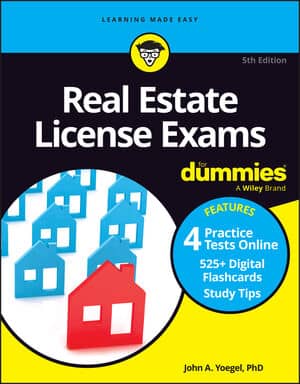Figuring out commission is the fun part for you. Pay day! But, the real Estate License Exam will also expect you to have a good grip on this. Discussing percentages is foremost, because most commissions are based on a percentage of the sale price of a property.
How to figure your commission
You’re a broker who sells a house. The owner has agreed to pay you a 5 percent commission. How much will you earn on the sale, if the house sells for $200,000?
Sale price x commission rate = commission earned
$200,000 x 0.05 = $10,000
Remember to turn 5 percent into a number you can use (in this case, 0.05) before you proceed with the rest of the problem.
How to figure out your commission rate
A variation on the commission problem has you figuring out your commission rate if you know the selling price of the property and the commission earned.
You sell a listed house for $200,000. You earn a $10,000 commission on the sale. What was your commission rate?
Commission earned ÷sale price = commission rate
$10,000 ÷$200,000 = .05 or 5 percent
How to figure commission splits
As a salesperson, your broker will pay you a share of the total commission earned for the sale. Remember that a salesperson works under the authority of a broker.
All commissions and commission splits are negotiable between the salesperson and the broker. In a math problem, this split may be expressed different ways. A problem may have a 60/40 split, which is 60 percent going to one party and 40 percent going to the other party. Whenever the commission shares are unequal, the problem will be clear as to what percentage each party gets.
Your firm receives a $20,000 commission that is to be split 60/40 between you and your broker. How much will you receive?
Commission amount x percentage share = commission amount share
$20,000 x 0.60 = $12,000
If you read the question carefully, the 60/40 split is in the same order as the “you and your broker.” If the problem doesn’t give you any more information, you have to interpret what test writers mean. Scan the following problem, which contains more than one split.
Suppose a $30,000 commission is earned on the sale of a house. The listing broker and the buyer’s broker agree to split the commission evenly. The listing salesperson receives 40 percent of the listing side. How much will the listing salesperson receive?
Where two brokers cooperate on a sale, they’re often referred to as the listing side (the broker who originally got the listing agreement to represent the seller) and the buyer’s side (the broker who finds the buyer). In this particular question, you also have to know that “split” evenly means that each of the sides gets half of the total commission.
$30,000 x 0.50 = $15,000 listing and buyer’s side because the commission is split evenly
$15,000 (listing side commission) x 0.40 (listing salesperson’s share) = $6,000 (listing salesperson’s commission)
A variation of this question uses the same information but asks you what the listing broker’s share was.
100 percent (total percentage of listing side commission) – 40 percent (listing salesperson’s percentage) = 60 percent listing broker’s percentage
$15,000 (total listing side commission) x.60 (listing broker’s percentage share) = $9,000 (listing broker’s share)

